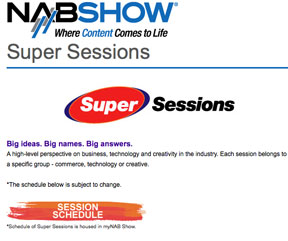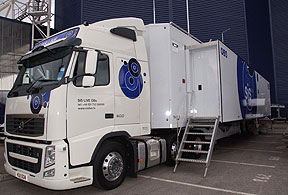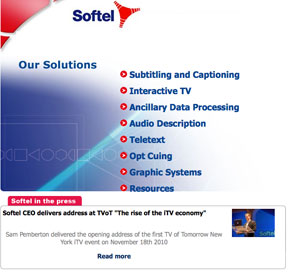- Civolution will be demonstrating new Second-Screen Synchronization and Automatic Content Recognition (ACR) applications at NAB2011 (booth: SU7917). These solutions enable synchronization of content between TV and other devices, such as tablets and mobiles, or within the TV itself. The Automatic Content Recognition solution is an integrated application in connected media devices such as smart TVs. It allows content (re)placement or triggering of events based on identifying the viewed content. Using advanced content identification technologies, triggered events are accurate and transparent to any type of distribution or time shift. The Second-Screen Synchronization application allows for the automatic identification of the TV channel being watched and the content being played. Upon identification it enables precise time-synchronization between content played on TV and mobile devices such as tablets and smart phones. The real-time interactivity between the devices, enabled by content identification, automatically handles distribution delays and supports time-shifted viewing.
-
The 2011 NAB Show will debut a Super Session examining the new ways in which content is delivered to consumers, and the impact these developments have on television's future. The session, titled Connected TV: Smart Devices, New Strategies, will be held Monday, April 11, at the NAB Show in Las Vegas. Led by moderator Will Richmond, president and founder of Broadband Directions LLC, the session will include panelists Richard Buchanan, VP of Video Services, Comcast Media Center; Wilfred Martis, GM of Retail CE Products, Digital Home Intel Corporation; Susan Panico, senior director of PlayStation Network, Sony Computer Entertainment America; Jack Perry, founder and CEO, Syncbak; and Paul Wehrley, co-founder and COO, Clicker. In addition to providing attendees with information on the latest developments in connected television and Internet video technologies, panelists will identify how content providers can expand their audience using new video platforms. New opportunities to present online material on television devices will also be discussed.
- SIS LIVE, Europe’s largest outside broadcast (OB) and satellite uplink supplier, has launched the next addition to its line-up of new-generation trucks, OB 5. The 13.5m x 3.9m vehicle is fully HD and 3G capable and is equipped for full 5.1 surround sound. The unit had its first outing on Saturday 2nd April with BBC coverage of the West Bromwich Albion v Liverpool premier league game for Match of the Day. OB 5 joins 13 other HD OB units, as part of SIS LIVE’s fleet of new-generation vehicles. All are designed to provide production teams with the latest equipment in a well-designed and comfortable environment. Both 1080i/50 pictures can be handled, as well as being future-proofed for 1080P/50 for progressive transmissions. The double capacity 3G infrastructure also makes the OB vehicle ideal for 3D signal processing and will allow SIS LIVE to continue to be at the forefront of this format. OB 5 can easily be configured as a powerful two-truck solution and can be integrated to work with the Company' latest HD VT vehicles. OB 5 will be used to cover football, including the Scottish Premier League, and also major national live events. It is already lined up for both the Royal Wedding and Glastonbury Music Festival. OB 5 has three main production areas, with a primary control desk, together with two secondary desks, allowing room for 12 people. The combined engineering and VTR area at the rear of the vehicle can carry up to 20 cameras, as well as four SloMo and four radio cameras. On board are 6 EVS LSM disk recorders. When operating with the second HD VT truck, there will be additional capacity for another 10 EVS operators, two production co-ordinators and an engineer.
- At the 2011 NAB Show, Softel is announcing a pioneering new integrated workflow for captioning and subtitling based on integration with Omneon products from Harmonic Inc. The joint solution works within media management applications based on Harmonic's Omneon Media Application Server™. The solution tightly integrates Softel's Swift™ vTX ancillary data encoding/transcoding system, allowing such workflows to be initiated and controlled through the Media Application Server under a highly usable single common interface. This comprehensive integration allows ancillary data in existing media assets to be extracted and used as metadata within the Omneon Media Application Server, streamlining the search and location of assets. Additionally, sub-clips can be created automatically using captions as start/end markers. Captions and subtitles can be extracted, transcoded and inserted in any format through the common interface, with support for closed captioning, open subtitling, Teletext and Softel MultiText™. The Omneon Media Application Server provides the foundation for the development and deployment of media-centric applications. By combining a single virtualized view of content across managed systems and fundamental media processing services, Media Application Server enables accelerated application development and minimizes the complexity of media management. The system offers tiered user access to content stored on the Harmonic infrastructure, permitting users to manipulate assets as appropriate, with Media Application Server coordinating applications to optimize workflows. Softel Swift vTX enables broadcasters and production facilities to repurpose content regardless of file format. It allows them to switch between SD and HD formats easily to facilitate multiplatform and worldwide distribution. Swift vTX supports an industry-leading array of files, wrappers and playout formats, facilitating the integration of ancillary data across a wide range of media servers and editing solutions. Softel MultiText enables early binding of multilingual subtitles to video assets, allowing broadcasters to be confident that automated or manual quality control processes can be completed well in advance of transmission.
Satnews Daily
April 5th, 2011
Of Interest To SatBroadcasting™ Professionals...





